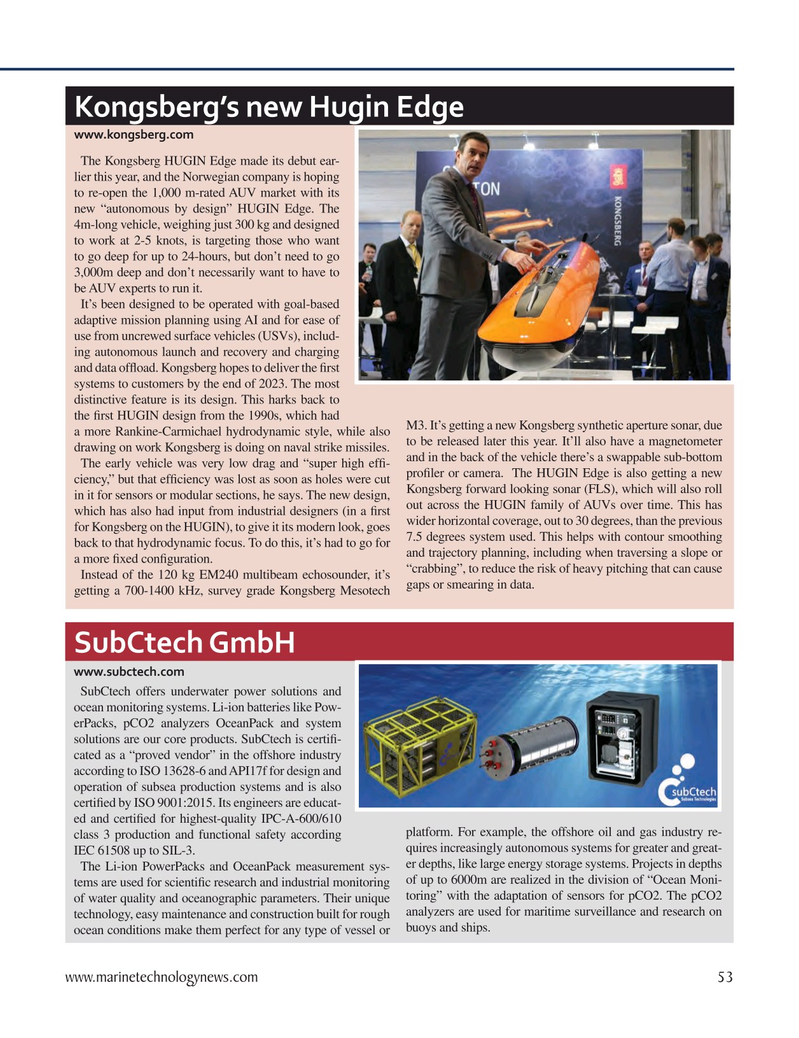
Page 53: of Marine Technology Magazine (September 2022)
Read this page in Pdf, Flash or Html5 edition of September 2022 Marine Technology Magazine
Kongsberg’s new Hugin Edge www.kongsberg.com
The Kongsberg HUGIN Edge made its debut ear- lier this year, and the Norwegian company is hoping to re-open the 1,000 m-rated AUV market with its new “autonomous by design” HUGIN Edge. The 4m-long vehicle, weighing just 300 kg and designed to work at 2-5 knots, is targeting those who want to go deep for up to 24-hours, but don’t need to go 3,000m deep and don’t necessarily want to have to be AUV experts to run it.
It’s been designed to be operated with goal-based adaptive mission planning using AI and for ease of use from uncrewed surface vehicles (USVs), includ- ing autonomous launch and recovery and charging and data of? oad. Kongsberg hopes to deliver the ? rst systems to customers by the end of 2023. The most distinctive feature is its design. This harks back to the ? rst HUGIN design from the 1990s, which had a more Rankine-Carmichael hydrodynamic style, while also M3. It’s getting a new Kongsberg synthetic aperture sonar, due to be released later this year. It’ll also have a magnetometer drawing on work Kongsberg is doing on naval strike missiles. and in the back of the vehicle there’s a swappable sub-bottom
The early vehicle was very low drag and “super high ef? - pro? ler or camera. The HUGIN Edge is also getting a new ciency,” but that ef? ciency was lost as soon as holes were cut
Kongsberg forward looking sonar (FLS), which will also roll in it for sensors or modular sections, he says. The new design, out across the HUGIN family of AUVs over time. This has which has also had input from industrial designers (in a ? rst wider horizontal coverage, out to 30 degrees, than the previous for Kongsberg on the HUGIN), to give it its modern look, goes 7.5 degrees system used. This helps with contour smoothing back to that hydrodynamic focus. To do this, it’s had to go for and trajectory planning, including when traversing a slope or a more ? xed con? guration.
Instead of the 120 kg EM240 multibeam echosounder, it’s “crabbing”, to reduce the risk of heavy pitching that can cause getting a 700-1400 kHz, survey grade Kongsberg Mesotech gaps or smearing in data.
SubCtech GmbH www.subctech.com
SubCtech offers underwater power solutions and ocean monitoring systems. Li-ion batteries like Pow- erPacks, pCO2 analyzers OceanPack and system solutions are our core products. SubCtech is certi? - cated as a “proved vendor” in the offshore industry according to ISO 13628-6 and API17f for design and operation of subsea production systems and is also certi? ed by ISO 9001:2015. Its engineers are educat- ed and certi? ed for highest-quality IPC-A-600/610 platform. For example, the offshore oil and gas industry re- class 3 production and functional safety according quires increasingly autonomous systems for greater and great-
IEC 61508 up to SIL-3.
er depths, like large energy storage systems. Projects in depths
The Li-ion PowerPacks and OceanPack measurement sys- tems are used for scienti? c research and industrial monitoring of up to 6000m are realized in the division of “Ocean Moni- of water quality and oceanographic parameters. Their unique toring” with the adaptation of sensors for pCO2. The pCO2 analyzers are used for maritime surveillance and research on technology, easy maintenance and construction built for rough ocean conditions make them perfect for any type of vessel or buoys and ships. www.marinetechnologynews.com 53
MTR #7 (50-65).indd 53 10/3/2022 8:54:59 AM

 52
52

 54
54
